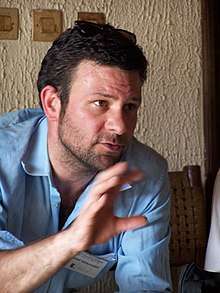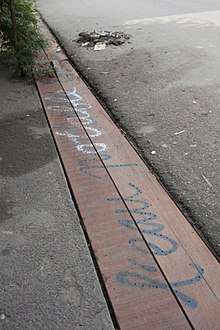Kamiel Verschuren
Kamiel Verschuren (Dordrecht, 24 September 1968) is a Dutch conceptual interdisciplinary visual artist, living and working in Rotterdam.[1]
Kamiel Verschuren | |
|---|---|
 Kamiel Verschuren | |
| Born | September 27, 1968 |
| Nationality | Dutch |
| Alma mater | Willem de Kooning Academy |
| Website | http://phk18.nl/kamiel-verschuren/ |
Biography
Verschuren was born in Dordrecht as son of Kees Verschuren, an artist from The Hague and art teacher at a local school. The next year the family moved back to The Haque where he grew up and attended the Haags Montessori Lyceum.[2]
From 1987 to 1992 Verschuren attended the Willem de Kooning Academy in Rotterdam.[1] In those days, in 1989, he was one of the founders of the Stichting B.A.D. art collective in southern Rotterdam in Charlois with Karin Arink and others.[3]
In the early 1990s, Verschuren came into prominence with exhibitions in Zoetermeer in 1994,[4] and in Rotterdam in gallery Phoebus in 1995.[5] In 1996 he took part in the artist initiative NEsTWORK with Karin Arink, Jeanne van Heeswijk, Ruud Welten and others, who participated in the first Manifesta exhibition in Rotterdam.[6][7][8][9] In 2000 he held a solo exhibition in the RAM Foundation in Rotterdam.[10]
To mainly work outside the context of the art world, museum and galleries, the activities of Verschuren resulted in collaborations with other artists, organizations and the establishment of several foundations and artist initiatives. He is active in several long-term collaborations with a.o. FSKE-Studio Galleria, S-Air (Sapporo Artists in Residence), artists’ initiative La Source du Lion in Morocco, East Street Arts in Leeds (GB), and doual’art in Cameroon.[3]
Work

Kamiel Verschuren is working in a broad international practice with a special interest for the public domain and the artist’s position in society from different positions; as a drawer, (spatial) designer, designer of public space, organizer, initiator, social activist, observer, teacher, urban advisor, landscape artist, producer and publicist; working individually and within divers partnerships with other artists and organizations.[11]
For Verschuren art is an open critical platform to engage with others, a global conversation, happening simultaneously at different places in which one can take part and sometimes join or even become the subject.
Leitmotiv in early and later work
Until 1998, Verschuren studied and worked on understanding and expending the concept of space and the idea of existentialism, often resulting in literary works (sound-text-video): installations, conceptual art, drawings, photo works and writings. He skilled himself to work in all media and techniques, except painting, as he believes there is no better or worse context for art.
In 1998, he decided to shift directions and started to work within realism and participation; within the context of daily life, in which art has to create its own context to be meaningful and in which artists have to re-find their role as part of society. Verschuren: “True meaning can only be found in the encounter with others through working together and by participating”.
Larger public commissions, public art projects and manifestations
In 1996-2005, he completed several larger public commissions often re-setting the original assignment to realize art as public space and creating examples for policy makers to extend their practice and policies. Since 1998, he is closely involved with the urban and social development of Rotterdam South, where he works and lives.
Starting in 2000, he initialized and realized over 60 public art projects and manifestations, such as:[3]
- Several public commissions ranging from The Shadow of the Image (1996),[12] the MaastunnelMonument NL (2003)[13] and the Penitentiary in Breda (2004–06)[14] to more recently De Schouwplaats (2014).[15]
- First four editions of the Open Studios Charlois (2001-2004)[3]
- International art manifestations Something over Charlois (2001-2003)[3]
- Sound installation for Poetry International (2006)[16][17]
- MoreLakeCity-X (2006)[18][19]
- Moving in Free Zones (2007)
- Overview exhibitions OnSouth#1 and OnSouth#2 (2010)[20]
- Sculpture garden De Schouwplaats[21][22]
In the late 2010s, with foundation Stedelinks010, Verschuren has been investing in the social and physical infrastructure of Rotterdam South, organizing an independent ferry boat to connect the south to the north of the city and a neighborhood pop-up restaurant (foundation Charlois aan het Water). The aim of these projects and initiatives is to create public life in the south area of Rotterdam, to connect and empower people, question authority and to create freedom by taking on responsibility.[23][24]
References
- Kamiel Verschuren ; male / Dutch ; conceptual artist, installation artist, draftsman, designer, author, photographer at rkd.nl. Last modification on: 2017-03-30.
- Ed. "Geslaagd 1986", Leidse Courant, 30 May 1986. p. 10.
- Kamiel Verschuren, rotterdamsekunstenaars.nl. Last updated 2019.
- Ed. "AGENDA BEELDENDE KUNST," De Volkskrant, 's-Hertogenbosch, 1994/09/02, p. 8.
- Ed. "BEELDENDE KUNST," de Volkskrant. 's-Hertogenbosch, 1995/09/08, p. 10
- Juan Cruz, Bartomeu Marí. Squatters: Witte de With, center for contemporary art, Rotterdam, July 15-December, 2001. Witte de With, 2002. p. 83.
- Claire Van Damme, e.a. What's in a name? Musea voor hedendaagse kunst in vraag gesteld. 2002. p. 47
- Jeanne van Heeswijk, Carlos Basualdo, Face your world. Wexner Center for the Arts, 2002. p. 32
- Barbara Vanderlinden, Elena Filipovic. The Manifesta Decade: Debates on Contemporary Art Exhibitions and Biennials in Post-wall Europe, MIT Press, 2005 - 33. p. 249.
- Ed. "When summer has almost gone." de Volkskrant, 7 September 2000.
- Kamiel Verschuren, Bureau Voor Kunst PHK18. Accessed 29.11.2019.
- The shadow of the image 1998; Kamiel Verschuren, at bkor.nl. Accessed 29.11.2019.
- Maas tunnel monument for road casualties NL 2003; Kamiel Verschuren, at bkor.nl. Accessed 29.11.2019.
- Tanja Karreman, Janine Schulze. Present: Kunst Bijrijksgebouwen 2004- 2006. 2007. p. 276
- De schouwplaats - BKOR - De schouwplaats; Kamiel Verschuren, at bkor.nl. Accessed 29.11.2019.
- Ward Wijndelts. "Poetry gaat duidelijk meer de visuele kant op," NRC Handelsblad. 21 Juni 2006.
- Ed. "Om acht uur gaat de homepage op zwart," de Volkskrant. 05-05-1999. Accessed 29-11-2019.
- Kunstenaars en ontwerpers over wonen en leven in Meerstad AT noorderbreedte.nl.2006/11/30. Accessed 29-11-2019.
- Adri van den Brink. Imaging the Future: Geo-visualisation for Participatory Spatial Planning in Europe, 2007. P. 137
- Sandra Smets. "Van fabriek tot sculptuur," NRC Handelsblad. 18 June 2010.
- Beeldentuin De Schouwplaats, at schouwplaats.wordpress.com. Accessed 29-11-2019.
- De schouwplaats (2012) ; Kamiel Verschuren at bkor.nl. Accessed 29-11-2019.
- Frank van Dijl. "Paviljoen met uitzicht op oude oceaanreus," NRC Handelsblad. 27 mei 2016.
- Twee nieuwe kunstenaars in Paviljoen aan het Water, at cbkrotterdam.nl, 2016/12/09. Accessed 29-11-2019.
Further reading
- Pensa, Iolanda (Ed.) Public Art in Africa. Art et transformations urbaines à Douala /// Art and Urban Transformations in Douala. Genève: Metis Presses, 2017. ISBN 978-2-94-0563-16-6
- Teeuwen, Roger ; Kamiel Verschuren. Taal in kunst : kroniek van de kunstmanifestatie NewCanvas Poetry and Art voor Poetry International Festival Rotterdam 2004-2006. Auteur: ; Poetry International Festival, Rotterdam.; stichting Studio NL 01.08.04, Rotterdam.
- Verschuren, Kamiel. Something about/... tets over, Stichting Something about Charlois, Rotterdam, 2003.
- Verschuren, Kamiel . Taal in Kunst. Hoorn: Hoogland & van Klaveren, 2009. ISBN 978-90-8967-032-8
External links
| Wikimedia Commons has media related to Kamiel Verschuren. |
- Kamiel Verschuren, rotterdamsekunstenaars.nl
- Kamiel Verschuren, Bureau Voor Kunst PHK18.